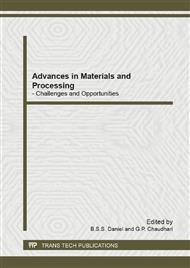p.412
p.417
p.425
p.430
p.435
p.440
p.445
p.450
p.455
Effect of Post Weld Heat Treatment on Mechanical Properties and Microstructure of Nickel Based Super Alloy Welds
Abstract:
In the present paper, Haynes 214 plate of 7mm thick was welded by Gas tungsten arc welding (GTAW) in two passes. The welded plates were subjected to post-weld heat treatment such as direct aging (DA) and solution treatment + aging (STA). The aging cycle was optimized using hardness by generating isothermal aging curve. The weld tensile properties, hardness test, microscopic analysis and fractographic studies were carried out in as-welded condition and at two different post-weld heat treatment conditions. The results show a significant increase in both yield and tensile strength after post weld heat treatment.
Info:
Periodical:
Pages:
435-439
Citation:
Online since:
November 2012
Authors:
Price:
Сopyright:
© 2012 Trans Tech Publications Ltd. All Rights Reserved
Share:
Citation:


